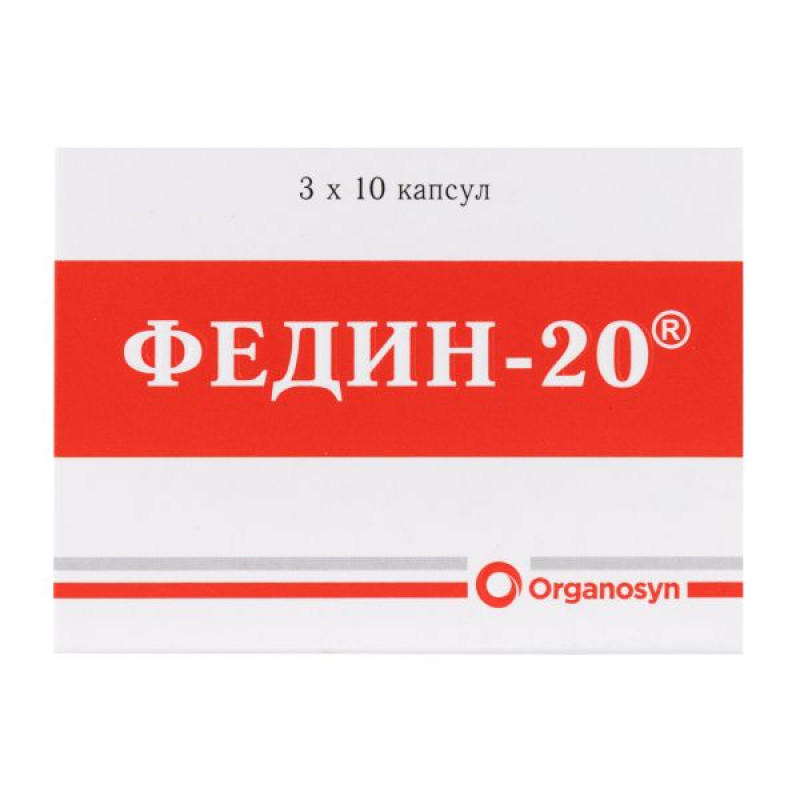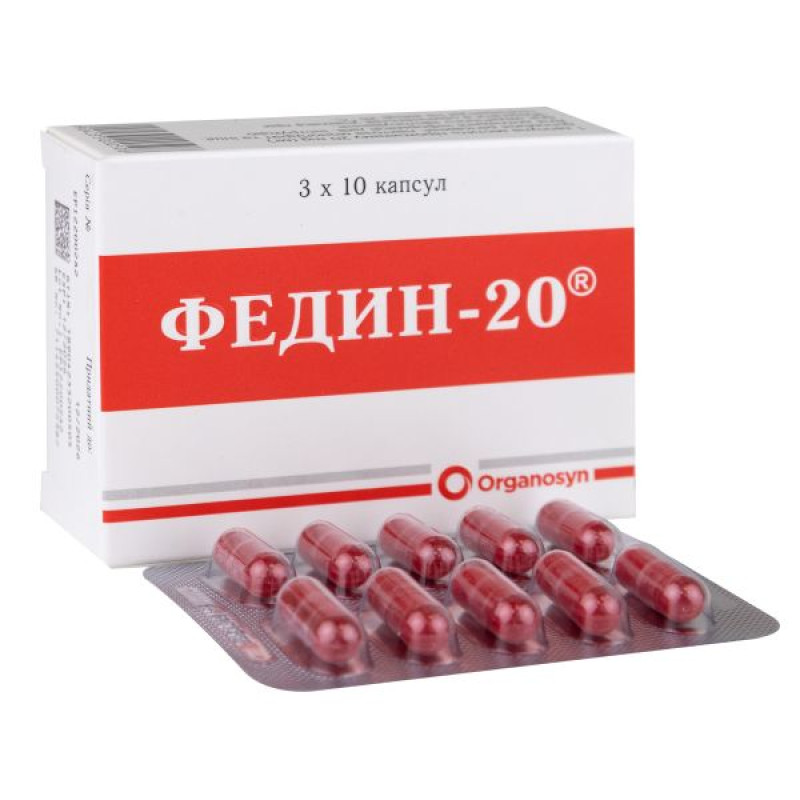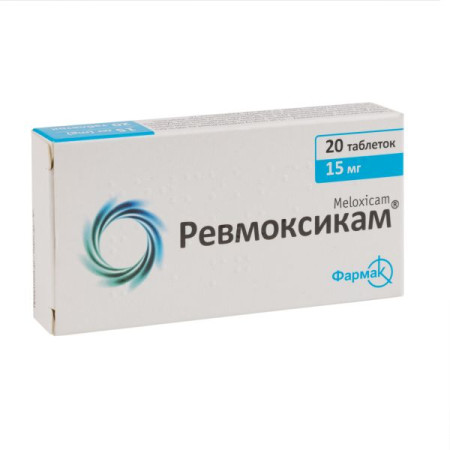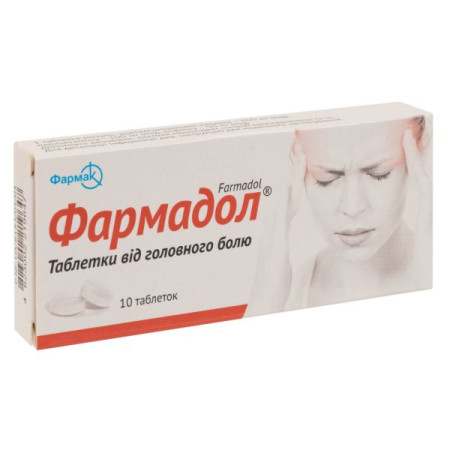Fedin-20 capsules 20 mg No. 30
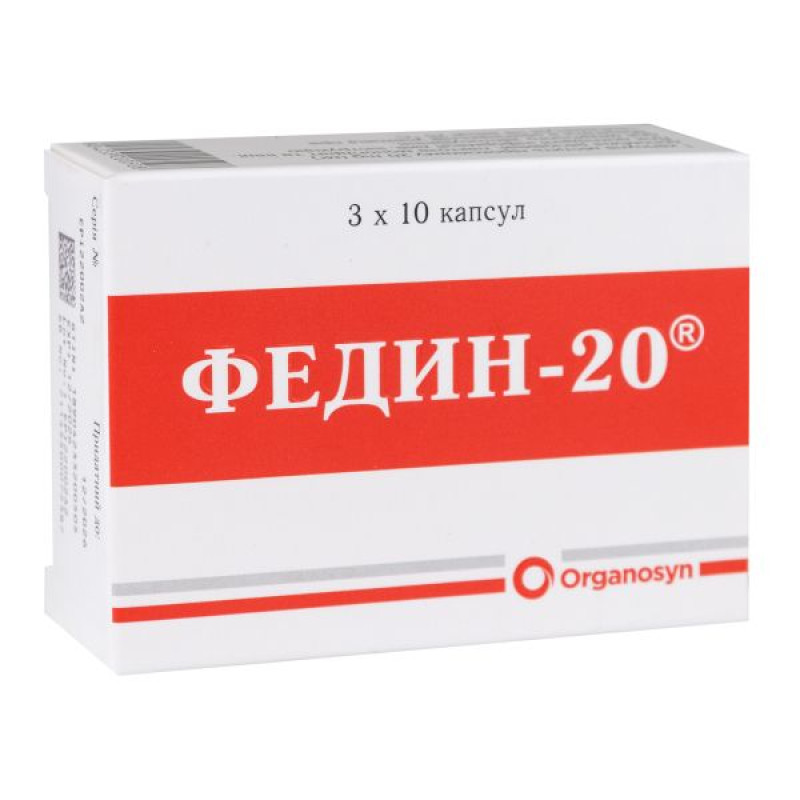
Instructions for use Fedin-20 capsules 20 mg No. 30
Composition
active ingredient: piroxicam;
1 capsule contains piroxicam 20 mg;
Excipients: lactose monohydrate, corn starch, colloidal anhydrous silicon dioxide.
Dosage form
Capsules.
Main physicochemical properties: hard gelatin capsules number 2, red body and cap, imprinted with “FEDIN 20” on the body and cap.
The capsules contain a white or almost white powder.
Pharmacotherapeutic group
Nonsteroidal anti-inflammatory and antirheumatic drugs. Oxicam derivatives. ATC code M01A C01.
Pharmacological properties
Pharmacodynamics
Pharmacological action - anti-inflammatory, analgesic, antipyretic, antiaggregatory. Reduces the synthesis of prostaglandins (PG), including PGE1, PGE2, PGE2-alpha and thromboxanes due to inhibition of cyclooxygenase activity. Suppresses phagocytosis, platelet aggregation. Helps reduce pain syndrome, symptoms of inflammation. In joint syndrome, reduces or stops inflammation and pain in the joints at rest and during movement, reduces morning stiffness and swelling of the joints.
Pharmacokinetics
When taken orally, it is well absorbed from the gastrointestinal tract, the maximum concentration is reached after 3-5 hours. The equilibrium concentration in the blood is reached within 7-12 days. Binding to plasma proteins is 97-99%. When used simultaneously with other drugs, it can displace them in binding to proteins, as a result of which it can enhance their therapeutic effect. Penetrates through the placental and blood-brain barriers. It is excreted in breast milk. It is metabolized in the liver, the main metabolites - 5-hydroxypiroxicam, N-methyl-benzosulfonamide and others - are pharmacologically inactive. The half-life is approximately 50 hours, may increase in liver diseases. It is excreted by the kidneys and through the gastrointestinal tract (in urine it is determined in 2 times greater quantities than in feces) mainly in the form of glucuronides (5% is excreted unchanged). Does not accumulate.
Indication
Symptomatic treatment of osteoarthritis, rheumatoid arthritis or ankylosing spondylitis. Due to its safety profile, piroxicam is not the first choice when other non-steroidal anti-inflammatory or antirheumatic drugs are indicated. The decision to prescribe piroxicam should be based on an assessment of the individual overall risk to the patient.
Contraindication
Use is contraindicated in:
history of gastrointestinal ulcers, bleeding or perforation; history of gastrointestinal disorders that may lead to bleeding, such as ulcerative colitis, Crohn's disease, gastrointestinal cancer or diverticulitis; active peptic ulcer, inflammatory gastrointestinal diseases or gastrointestinal bleeding; bleeding diathesis, changes in the blood picture of unclear genesis (including history); concomitant use with other non-steroidal anti-inflammatory drugs (NSAIDs), including selective COX-2 inhibitors and acetylsalicylic acid at analgesic doses; concomitant use with anticoagulants; history of serious allergic reactions of any type, especially skin reactions such as erythema multiforme, Stevens-Johnson syndrome, toxic epidermal necrolysis; hypersensitivity to the active or auxiliary substances of the drug, transient skin reactions (regardless of their severity) in response to the use of piroxicam, other non-steroidal anti-inflammatory and antirheumatic drugs and other drugs; severe heart failure; severe renal or hepatic failure; use of acetylsalicylic acid and other NSAIDs in patients in whom the latter induced the development of bronchial asthma, allergic rhinitis, nasal polyps, angioedema and/or urticaria.
Interaction with other medicinal products and other types of interactions
Caution should be exercised in patients who have taken any of the following medications.
As with other NSAIDs, the use of piroxicam with acetylsalicylic acid or concomitant use with other NSAIDs, including other formulations of piroxicam, should be avoided, as there is insufficient evidence that such a combination leads to a greater improvement than that achieved with piroxicam alone. In addition, the potential for adverse effects is increased. Studies have shown that in humans, concomitant administration of piroxicam and acetylsalicylic acid results in an 80% reduction in plasma concentrations of piroxicam compared to normal values.
Aspirin and other NSAIDs: Piroxicam, like other NSAIDs, reduces platelet aggregation and increases bleeding time. This effect should be taken into account when determining bleeding time.
Corticosteroids: increased risk of gastrointestinal ulceration or bleeding. Anticoagulants: NSAIDs, including piroxicam, may enhance the effects of anticoagulants such as warfarin. Therefore, concomitant use of piroxicam with anticoagulants such as warfarin should be avoided.
Methotrexate: Methotrexate excretion is reduced, which may lead to acute toxicity.
Cyclosporine, tacrolimus: possible increased risk of nephrotoxicity.
Cyclosporine: increased risk of gastrointestinal damage, kidney and/or liver damage (avoid combination with low doses of piroxicam, monitoring of kidney and liver function is recommended).
Cimetidine. Two separate studies have shown a small but statistically significant increase in the absorption of piroxicam after administration of cimetidine. No significant changes in the elimination rate constant or half-life were observed. This phenomenon is not considered to be of clinical significance.
Antiplatelet agents and selective serotonin reuptake inhibitors (SSRIs): increased risk of gastrointestinal bleeding.
Probenecid: reduces the metabolism and excretion of NSAIDs and their metabolites when used concomitantly.
Oral antidiabetic drugs: NSAIDs inhibit the metabolism of sulfonylureas and increase the risk of hypoglycemia.
Lithium: Piroxicam may increase plasma levels of lithium salts and prolong and potentiate their effects.
The simultaneous use of piroxicam and immunosuppressants leads to increased toxicity.
Phenytoin: possible increase in phenytoin blood levels, appropriate monitoring and dose adjustment is recommended if piroxicam therapy is initiated, adjustment and discontinuation if necessary.
Diuretics: NSAIDs, including piroxicam, may reduce the therapeutic efficacy of diuretics when used concomitantly. There is a risk of hyperkalemia when piroxicam is used concomitantly with potassium-sparing diuretics or other potassium-containing medicinal products. Diuretics may increase the nephrotoxic effects of NSAIDs.
Antihypertensive drugs: Piroxicam may reduce the antihypertensive effect of ACE inhibitors and beta-blockers when used concomitantly.
Quinolones: Concomitant use of quinolones and piroxicam may increase the risk of seizures in patients with or without a history of epilepsy or seizures.
Mifepristone: NSAIDs may interfere with the action of mifepristone in terminating pregnancy.
Cardiac glycosides: NSAIDs increase plasma concentrations and reduce glomerular filtration of cardiac glycosides when both drugs are used simultaneously. There is no change in the pharmacokinetics of piroxicam.
Digoxin, digitoxin: Concomitant therapy with piroxicam and digoxin or piroxicam and digitoxin had no effect on the plasma levels of either drug.
Cyclophosphamide, vinca alkaloids: taking piroxicam before or after treatment with these drugs may result in increased adverse reactions of these substances (the combination should be avoided).
Alcohol: deterioration of drug tolerance (should be avoided).
Highly protein-bound drugs: Piroxicam is highly protein-bound and may displace other protein-bound drugs. When administering piroxicam to patients taking other highly protein-bound drugs, physicians should closely monitor the patient's condition and adjust the dose if necessary.
No interaction of piroxicam with antacids, cimetidine, and furosemide has been identified when taken simultaneously.
Application features
Due to its safety profile, piroxicam is not a first-line treatment when other nonsteroidal anti-inflammatory and antirheumatic drugs are indicated.
The decision to prescribe piroxicam should be based on an assessment of the individual patient's overall risk. Adverse effects can be minimized by using the lowest effective dose for the shortest duration necessary to control symptoms.
Clinical benefit and tolerability should be reviewed periodically, and treatment should be discontinued immediately at the first appearance of skin reactions or clinically significant gastrointestinal reactions.
Elderly patients are at increased risk of adverse reactions to NSAIDs, especially gastrointestinal bleeding and perforation, which can be fatal.
Gastrointestinal effects, risk of gastrointestinal ulcers, bleeding and perforation. Patients at risk.
NSAIDs, including piroxicam, can cause serious gastrointestinal reactions such as bleeding, ulceration and perforation of the stomach, small intestine and colon, which can be fatal. These serious adverse reactions can occur at any time with or without warning symptoms in patients treated with nonsteroidal anti-inflammatory and antirheumatic drugs, oral corticosteroids, SSRIs or antiplatelet agents such as low-dose acetylsalicylic acid. Both short- and long-acting NSAIDs carry an increased risk of serious gastrointestinal toxicity.
The risk of developing serious gastrointestinal complications increases with age. Age over 70 years is associated with a high risk of complications. Use of the drug should be avoided in patients over 80 years of age.
The need for combination treatment with gastroprotective drugs (e.g. misoprostol or proton pump inhibitors) should be considered with caution, especially in elderly patients.
During treatment with piroxicam, patients and physicians should monitor closely for symptoms of gastrointestinal ulceration and bleeding. Patients should be asked to report any new or unusual abdominal symptoms during treatment. If there is any doubt about the presence of a gastrointestinal complication during treatment, piroxicam should be discontinued immediately and alternative treatment should be considered.
Cardiovascular and cerebrovascular effects.
Appropriate monitoring and caution should be exercised in patients with a history of hypertension and mild to moderate congestive heart failure, as edema and fluid retention have been reported in association with NSAID treatment.
Clinical trials and epidemiological data suggest that the use of NSAIDs (especially at high doses and over long periods) may be associated with a small increased risk of arterial thrombotic events (e.g. myocardial infarction or stroke). There are insufficient data to exclude such a risk for piroxicam.
The drug should be prescribed with caution in patients with a history of coagulation disorders, since piroxicam inhibits prostaglandin biosynthesis and affects platelet function. Patients with uncontrolled hypertension, congestive heart failure, established ischemic heart disease, peripheral arterial disease and cerebrovascular disease should be prescribed piroxicam only after a careful risk/benefit assessment. Such an assessment is necessary before starting long-term treatment in patients with risk factors for cardiovascular events (e.g., hypertension, hyperlipidemia, diabetes mellitus, smoking).
The drug should be prescribed with caution to patients with a history of bronchial asthma.
Skin reactions.
Serious skin reactions, some of which were fatal, have been reported very rarely in association with the use of NSAIDs, including reports of exfoliative dermatitis, Stevens-Johnson syndrome and toxic epidermal necrolysis. Observational data suggest that the use of piroxicam may be associated with a higher risk of serious skin reactions than other non-oxicam NSAIDs. Patients are likely to be at highest risk of developing these reactions at the beginning of treatment. The onset of the reaction is in most cases within the first month of treatment. Piroxicam should be discontinued at the first appearance of skin rash, mucosal lesions or other signs of hypersensitivity.
Piroxicam should be used with caution in patients with renal impairment because of the potential for renal damage. In rare cases, the drug may cause interstitial nephritis, glomerulonephritis, renal papillary necrosis, or nephrotic syndrome. Piroxicam, like other NSAIDs, inhibits the synthesis of renal prostaglandins that maintain renal perfusion in patients with reduced renal blood flow and total blood volume. In such patients, the use of NSAIDs may cause severe renal decompensation, requiring discontinuation of treatment. Patients with congestive heart failure, cirrhosis, nephrotic syndrome, and renal disease are at greatest risk of such complications and should be closely monitored during NSAID treatment.
Long-term treatment with piroxicam, like other NSAIDs, may cause changes in liver function, requiring periodic monitoring of liver enzymes.
As a result of its anti-inflammatory action, the drug may mask the symptoms of acute inflammation, so when prescribing it, the presence of a bacterial infection should be excluded.
There is a risk of hyperkalemia when using NSAIDs, especially in patients over 65 years of age, in patients with renal insufficiency, in patients treated with beta-blockers, ACE inhibitors and potassium-sparing diuretics. In these patients, serum potassium should be monitored.
Piroxicam reversibly inhibits fertility in women of reproductive age, which should be considered when trying to become pregnant.
The drug should not be prescribed for the treatment of postoperative pain in the setting of coronary artery bypass grafting.
Piroxicam should be used in patients with adaptive porphyria only after careful risk/benefit assessment, as exacerbation of the disease is possible.
During prolonged use of analgesics, a headache may develop that cannot be resolved by increasing the dose or using another NSAID.
Before prescribing to patients with bronchial asthma, allergic rhinitis, nasal polyps, and chronic obstructive respiratory diseases, it is necessary to determine the appropriateness of prescribing the drug.
You should not drink alcohol during treatment.
Patients with rare hereditary problems of galactose intolerance, the Lapp lactase deficiency or glucose-galactose malabsorption should not take this medicine.
Ability to influence reaction speed when driving vehicles or other mechanisms
Piroxicam may cause side effects such as tinnitus, dizziness, drowsiness, hearing and visual disturbances, which may impair active attention and reflexes. During treatment with the drug, it is better to refrain from driving vehicles and working with other mechanisms, performing other work that requires concentration.
Use during pregnancy or breastfeeding
Pregnancy: Piroxicam should not be used during pregnancy.
Piroxicam reduces the synthesis and release of prostaglandins by reversible blockade of the enzyme cyclooxygenase. This effect, as with other NSAIDs, has been associated with an increase in the incidence of difficult and prolonged labor in experimental animals if the drug is continued into late pregnancy. NSAIDs have a known potential to induce premature closure of the ductus arteriosus in the newborn.
Inhibition of prostaglandin synthesis may adversely affect the course of pregnancy and/or the intrauterine development of the fetus. Epidemiological data suggest an increased risk of miscarriage, as well as cardiac malformations and gastroschisis, following the use of prostaglandin synthesis inhibitors in early pregnancy. The risk appears to be dose- and duration-dependent.
During the third trimester of pregnancy, prostaglandin synthesis inhibitors may cause the following risks to the fetus:
Cardiopulmonary defects (with premature closure of the ductus arteriosus and pulmonary hypertension); Renal functional disorders, which can progress to renal failure, as well as oligohydramnios.
Cause the following risks to the mother and fetus before delivery:
Prolongation of bleeding time, inhibition of platelet aggregation, which may occur even at very low doses; Inhibition of uterine contractions, which will lead to delayed or prolonged labor.
Prostaglandin synthesis inhibitors are contraindicated during the third trimester of pregnancy.
Breastfeeding. The active substance piroxicam and its breakdown products pass into breast milk, but in small quantities. Due to the lack of clinical studies to determine its safety, piroxicam is contraindicated during breastfeeding.
Therefore, the use of the drug during breastfeeding is contraindicated or breastfeeding should be discontinued for the period of treatment.
Fertility
Piroxicam, like other NSAIDs, is known to inhibit cyclooxygenase/prostaglandin synthesis, which may impair female fertility and is therefore not recommended in women attempting to conceive. In women who have difficulty conceiving or who are undergoing investigation of infertility, discontinuation of piroxicam should be considered.
Method of administration and doses
Initial prescription of piroxicam should be made by a physician experienced in the diagnostic evaluation and treatment of patients with inflammatory or degenerative rheumatic diseases. The maximum recommended daily dose is 20 mg.
Adverse reactions can be reduced by using the lowest effective dose for the shortest period of time necessary to control symptoms.
The benefit of treatment and tolerability of the drug should be reassessed every 14 days. If long-term treatment is considered necessary, this reassessment should be carried out more frequently. Given the proven fact that the use of piroxicam is associated with an increased risk of gastrointestinal complications, the need for combination treatment with gastroprotective drugs (e.g. misoprostol or proton pump inhibitors) should be carefully considered, especially in elderly patients.
Adults should take 1 capsule of 20 mg orally once a day, preferably during or immediately after meals, with water.
The duration of treatment depends on the course of the disease and is determined by the doctor.
The total daily dose should not exceed 20 mg.
Elderly patients (people over 65 years of age).
Due to the increased risk of adverse reactions, elderly patients should be under constant medical supervision. For patients over 70 years of age, the dose and duration of treatment should be reduced. Do not use in patients over 80 years of age.
Patients with renal impairment.
Dose reductions should not be made for patients with mild to moderate renal impairment. Piroxicam is contraindicated in patients with severe renal impairment.
Patients with impaired liver function.
Dose reductions should not be made for patients with mild to moderate hepatic impairment. Piroxicam is contraindicated in patients with severe hepatic impairment.
It is not used in children under 18 years of age, as there is insufficient clinical experience regarding the safe use of piroxicam in this age group of patients.
Overdose
Symptoms: It is necessary to take into account the stages of manifestation of gastrointestinal disorders, such as nausea, vomiting, abdominal pain, epigastric pain, possible gastrointestinal bleeding; anaphylactic reactions; dizziness, headache, arterial hypertension, visual disturbances, confusion, drowsiness, tinnitus and hyperventilation with respiratory alkalosis; when using large doses - loss of consciousness.
In later stages, depression of the central nervous system, hyperthermia, respiratory and metabolic acidosis, respiratory depression, toxic circulatory failure, impaired renal function (hematuria, proteinuria, acute renal failure), as well as liver (hypoprothrombinemia), cerebral and pulmonary edema, and an increased likelihood of seizures and coma may develop.
Treatment: symptomatic and supportive treatment is performed (gastric lavage, administration of activated charcoal no later than 6 hours after taking the drug, use of antacids, acceleration of diuresis, formation of an acidic urine reaction).
There is no specific antidote. The long half-life of piroxicam should be taken into account. Based on animal studies, it is assumed that the elimination of piroxicam can be accelerated by the administration of antacids and activated charcoal.
Primary elimination of the drug (careful gastric lavage); monitoring of acid-base balance; correction of electrolyte levels, correction of glucose levels; intensive medical care; acceleration of the elimination process (alkalized, forced diuresis); administration of diazepam in case of seizures.
The administration of activated charcoal (only to conscious patients!) affects the resorption and absorption of piroxicam, and thus reduces the total amount of the drug's active substance in the blood serum.
Studies on the use of hemodialysis to accelerate elimination have not been conducted, however, hemodialysis may not be successful due to the high protein binding of piroxicam.
Adverse reactions
Gastrointestinal: stomach discomfort, indigestion, anorexia, epigastric pain, constipation, diarrhea, dyspepsia, flatulence, exacerbation of colitis or Crohn's disease, severe bleeding/perforation (there is a risk of asymptomatic perforation), heartburn, nausea, ulcers (gastric, duodenal), vomiting, dry mouth, esophagitis, gastritis, glossitis, hematemesis, hepatitis, jaundice, melena, rectal bleeding, stomatitis, eructation, liver dysfunction, pancreatitis, fatal cases.
From the side of the central nervous system: dizziness, headache, anxiety, weakness, impaired concentration, depression, abnormal dreams, drowsiness, insomnia, fatigue, irritability, paresthesia, tremor, vertigo, akathisia, seizures, coma, hallucinations, meningitis, mood swings, psychotic reactions, sensory disturbances, memory disorders, confusion, nervousness, feeling of disorientation.
Cardiovascular system: edema, heart failure, hypertension, tachycardia, fainting, arrhythmia, exacerbation of angina pectoris, hypotension, myocardial infarction, palpitations, vasculitis, increased risk of thrombotic events (myocardial infarction or stroke).
From the side of the hematopoietic and lymphatic systems: anemia, increased bleeding time, ecchymosis, eosinophilia, epistaxis, leukopenia, nonthrombocytopenic Schönlein-Henoch purpura, the appearance of antinuclear antibodies, petechial rashes, thrombocytopenia, agranulocytosis, hemolytic anemia, aplastic anemia, lymphadenopathy, pancytopenia, decreased hemoglobin and hematocrit not associated with gastrointestinal bleeding.
Skin and subcutaneous tissue disorders: itching, rash, alopecia, hematoma, peeling, photosensitivity, increased sweating, angioedema, toxic epidermal necrolysis (Lyell's syndrome), exfoliative dermatitis, onycholysis, Stevens-Johnson syndrome, urticaria, erythema multiforme, bullous eruptions, redness, eczema, allergic-type purpura, eczema.
On the part of the immune system: hypersensitivity reactions, asthmatic attacks (bronchospasm), urticaria/angioedema, anaphylactic or anaphylactoid reactions in patients with allergies, serum sickness, the appearance of antinuclear antibodies, vasculitis.
From the urinary system: edema, renal dysfunction, cystitis, dysuria, hematuria, hyperkalemia, interstitial nephritis, nephrotic syndrome, oliguria/polyuria, proteinuria, acute renal failure, papillary necrosis, reversible increase in plasma urea and creatinine levels.
From the reproductive system and mammary glands: decreased female fertility.
On the part of the organs of vision: diplopia, blurred vision, conjunctivitis, eye irritation and swelling, vision impairment.
From the auditory system: hearing impairment, tinnitus, ringing in the ears.
Respiratory: respiratory depression, pneumonia.
Hepatobiliary disorders: increased serum transaminases (ALAT, ASAT), transient increase in bilirubin; toxic hepatitis with or without jaundice, fulminant hepatitis, hepatic failure.
Metabolic disorders: hypoglycemia, hyperglycemia, fluid retention.
Expiration date
4 years.
Storage conditions
Store in the original packaging at a temperature not exceeding 25 °C.
Keep out of reach of children.
Packaging
10 capsules in a blister made of aluminum foil and polyvinyl chloride film. 3 blisters in a cardboard pack.
Vacation category
According to the recipe.
Producer
Evertogen Life Sciences Limited.
Location of the manufacturer and its business address
Plot No: S-8, S-9, S-13/P & S-14/P TSIIC, Pharma SEZ, Green Industrial Park, Polepally (V), Jadcherla (M), Mahabubnagar, Telangana, IN-509 301, India.
There are no reviews for this product.
There are no reviews for this product, be the first to leave your review.
No questions about this product, be the first and ask your question.




